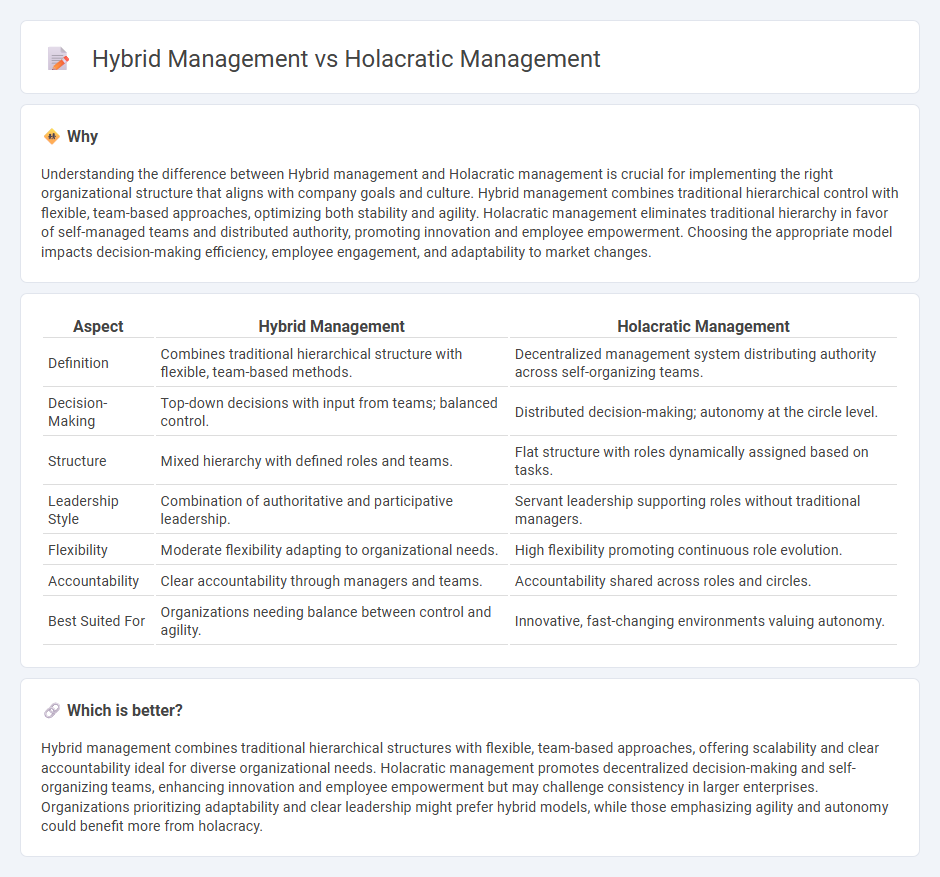
Hybrid management combines traditional hierarchical structures with collaborative, flexible approaches to enhance adaptability and employee involvement, while holacratic management eliminates centralized authority in favor of distributed decision-making through self-organizing teams. Organizations adopting hybrid models benefit from a balance of clear leadership and agile responsiveness, whereas holacracy emphasizes transparency, roles clarity, and autonomy to foster innovation. Explore the advantages and challenges of these management styles to determine the best fit for your organizational needs.
Why it is important
Understanding the difference between Hybrid management and Holacratic management is crucial for implementing the right organizational structure that aligns with company goals and culture. Hybrid management combines traditional hierarchical control with flexible, team-based approaches, optimizing both stability and agility. Holacratic management eliminates traditional hierarchy in favor of self-managed teams and distributed authority, promoting innovation and employee empowerment. Choosing the appropriate model impacts decision-making efficiency, employee engagement, and adaptability to market changes.
Comparison Table
| Aspect | Hybrid Management | Holacratic Management |
|---|---|---|
| Definition | Combines traditional hierarchical structure with flexible, team-based methods. | Decentralized management system distributing authority across self-organizing teams. |
| Decision-Making | Top-down decisions with input from teams; balanced control. | Distributed decision-making; autonomy at the circle level. |
| Structure | Mixed hierarchy with defined roles and teams. | Flat structure with roles dynamically assigned based on tasks. |
| Leadership Style | Combination of authoritative and participative leadership. | Servant leadership supporting roles without traditional managers. |
| Flexibility | Moderate flexibility adapting to organizational needs. | High flexibility promoting continuous role evolution. |
| Accountability | Clear accountability through managers and teams. | Accountability shared across roles and circles. |
| Best Suited For | Organizations needing balance between control and agility. | Innovative, fast-changing environments valuing autonomy. |
Which is better?
Hybrid management combines traditional hierarchical structures with flexible, team-based approaches, offering scalability and clear accountability ideal for diverse organizational needs. Holacratic management promotes decentralized decision-making and self-organizing teams, enhancing innovation and employee empowerment but may challenge consistency in larger enterprises. Organizations prioritizing adaptability and clear leadership might prefer hybrid models, while those emphasizing agility and autonomy could benefit more from holacracy.
Connection
Hybrid management integrates traditional hierarchical structures with elements of holacratic management, enabling flexibility and distributed authority within organizations. Holacratic management emphasizes decentralized decision-making through self-organizing teams, which hybrid models adopt selectively to improve agility and employee autonomy. This fusion allows companies to balance control with empowerment, optimizing operational efficiency and innovation.
Key Terms
Holacratic management:
Holacratic management emphasizes decentralized authority by distributing decision-making across self-organizing teams, enhancing agility and employee empowerment. It eliminates traditional hierarchies, fostering transparency through defined roles and dynamic governance meetings, leading to increased innovation and rapid adaptation. Explore more about how Holacratic management can transform organizational culture and performance.
Self-organization
Holacratic management centers on self-organization by distributing authority across roles, enabling teams to operate autonomously without traditional hierarchical constraints. Hybrid management blends elements of self-organization with conventional top-down oversight, allowing flexibility while maintaining strategic control. Discover how these approaches impact organizational agility and employee empowerment.
Governance meetings
Holacratic management emphasizes structured governance meetings where roles, policies, and tensions are addressed systematically to ensure self-organization and agility. Hybrid management blends traditional hierarchical elements with holacratic principles, resulting in governance meetings that balance top-down decision-making and distributed authority. Explore detailed comparisons of governance practices in holacratic and hybrid models to optimize organizational effectiveness.
Source and External Links
Holacracy - Overview, How it Works, and Advantages - Holacracy is a decentralized management system where self-governing teams (holons) hold decision-making authority, replacing traditional managerial hierarchies with roles instead of job descriptions and promoting autonomy to achieve organization-wide goals.
Holacracy - Wikipedia - Holacracy is a method of organizational governance distributing authority among roles within a holarchy, allowing individuals high autonomy to act and innovate without needing permission, supported by structured tactical meetings to maintain focus and efficiency.
What is Holacracy & How Can it Transform the Workplace? - Runn - Holacracy consists of autonomous, self-managed teams called circles, where roles and policies are defined collaboratively, promoting decentralized management, continuous improvement during work processes, and a healthy, flexible environment distinct from traditional hierarchical management.
 dowidth.com
dowidth.com